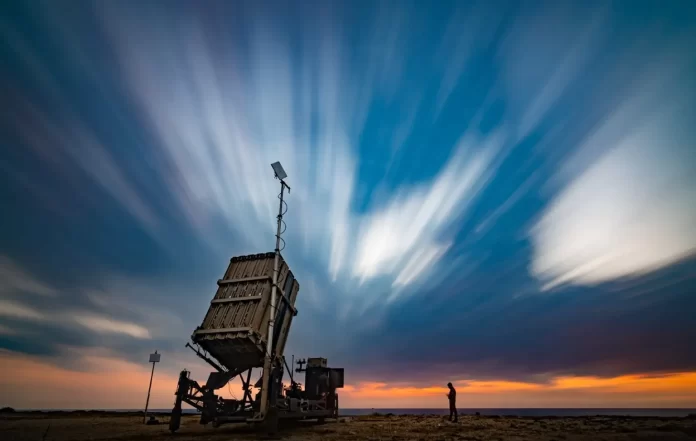7 June 2024: Lebanon-based Hezbollah has claimed the destruction of Israel’s Iron Dome air defense system, multiple reports said on Thursday. The reported destruction came at a time when Israeli Prime Minister Benjamin Netanyahu sent out a warning that his country could begin “very intense” operations near Lebanon.
Hezbollah claimed on June 5 that it struck an Iron Dome air defense system launcher near the Ramot Naftali, or what Hezbollah refers to as the “northern occupied Palestine.”
The claims were supported by a video from the group showing a guided missile hitting the launcher. However, Israeli media said that the aftermath of the attack was not known.
Hours after the claims first emerged, a couple of other visuals were released that have been circulating on social media. The video shows an Iron Dome battery, stationed in an Israel Defense Force (IDF) barrack, being hit in a precision strike.
On its part, the IDF refused to acknowledge that an attack was conducted on the Iron Dome system. Earlier, on June 2, Hezbollah claimed to have destroyed the radar of the Iron Dome system in Golan Heights using attack drones. As per claims, the drones rammed into the radar, causing an explosion, killing and injuring troops around it.
However, the video triggered a wave of jubilation among pro-Iranian and pro-Palestinian netizens on Platform X, who said that Hezbollah had made history with the first-ever destruction of an Iron Dome battery.
Some observers noted that while Gaza-based Hamas have attempted to destroy the Iron Dome, there is no credible evidence to suggest that they succeeded. This has made the Hezbollah attack even more significant. Some netizens suggested that it was ironic that a system meant to destroy incoming missiles was destroyed by a hostile missile.
Israel has extensively used the Iron Dome system against incoming targets from Hezbollah, which is allegedly backed by the Iranian regime, since Tel Aviv launched a bombing campaign against Gaza after a Hamas attack in October 2023. The system was credited to have shot down 99% of the aerial targets launched by Iran in a large-scale attack in April 2024.
The Iron Dome is a strategic part of Israel’s multi-layered air defense system. Developed by Israel with support from the United States, it is designed to knock down short-range rockets. Israel maintains that since the system entered service, it has intercepted thousands of missiles, many of them from the ongoing conflict with Hamas and Hezbollah. According to the IDF, the system has a success rate of over 90%.
Against that backdrop, its inability to destroy a Hezbollah rocket has become a talking point on social media and has drawn attention to Hezbollah’s burgeoning capability. There are claims that Hezbollah has increased access to sophisticated weapons, with equipment from Syria smuggled to it by Iran.
Israel and Hezbollah have been engaged in regular firing and attacks since October last year, prompted by the militia’s protest against the Israeli war on Gaza, which has now killed more than 36,000 people (mostly civilians) and has been condemned globally. In November last year, the militant organization told the US that Israel’s unrelenting campaign could trigger a region-wide escalation.
Nonetheless, the recent destruction of an Iron Dome battery comes at a time when hostilities between Hezbollah and Israel have intensified.
Following nearly eight months of daily gunfire between Israeli troops and Hezbollah fighters along their border in Lebanon, Prime Minister Benjamin Netanyahu said Israel was “prepared for a very intense operation”.
Over the past week, there has been an increase in the fighting between Israel and the Lebanese armed group. Israel has been hitting farther into Lebanese territory, which has raised fears that the heavily armed enemies may start a bigger confrontation.
“We are prepared for a very intense operation in the north. One way or another, we will restore security to the north,” Netanyahu said during a visit to the border area.
Israel has increased its attacks on Hezbollah members and Palestinian and Lebanese fighters who travel in cars and motorcycles around Lebanon. In response to this, Hezbollah launched a drone attack on June 5, injuring at least ten people, one gravely.
Netanyahu’s far-right coalition colleagues, National Security Minister Itamar Ben-Gvir and Finance Minister Bezalel Smotrich, have also called for swift action. “They burn us here, all Hezbollah strongholds should also burn and be destroyed. WAR!” Ben Gvir recently said on Telegram.
Israel’s Chief of the General Staff, Herzi Halevi, has also shown his keenness to start an offensive. He said, “We are prepared after a very good process of training up to the level of a General Staff exercise to move to an offensive in the north. We are approaching a decision point.”
Since October 7, around 300 Hezbollah members and 80 civilians have been killed by Israeli strikes. The Israeli military reported that 18 Israeli soldiers and 10 civilians had died in attacks carried out from Lebanon.
Sheikh Naim Qassem, the deputy head of Hezbollah, has noted that although the group has not decided to expand the conflict, it would fight one if it was forced to. He warned that Hezbollah had just used a small portion of its potential and that Israel would face “devastation, destruction, and displacement” if it expanded the conflict.




